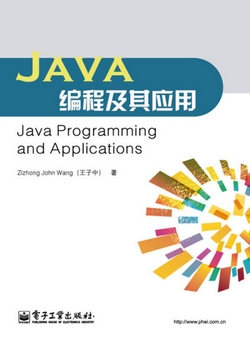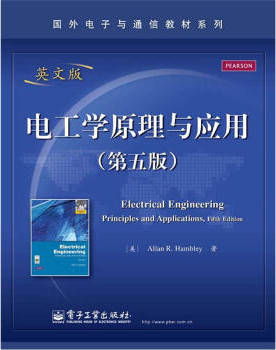Java编程及其应用
作者: 王子中
出版时间:2014年11月
出版社:电子工业出版社
- 电子工业出版社
- 9787121245114
- 1-1
- 133314
- 0047151223-6
- 平装
- 16开
- 2014年11月
- 480
- 308
- TP312JA
- 编程语言
- 研究生、本科
Chapter 1 Introduction
1.1 What is a Computer
1.2 Instruction Execution Cycle
1.3 Compilers and Interpreters
1.4 Programs and Algorithms
1.5 Code Debugging
1.6 Compiling and Execution
1.7 Chapter Exercises
Chapter 2 Characters and Strings
2.1 Java Program Components
2.2 Naming Identifiers
2.3 Characters and Strings
2.4 Declaration of Variables
2.5 Assignment Statements
2.6 Named Constants
2.7 Standard Output
2.8 Standard Input
2.9 String Concatenation
2.10 The Length of a String
2.11 The Preprocessor
2.12 Chapter Exercises
Chapter 3 Numerical Data
3.1 Integers and Floating Numbers
3.2 Arithmetic Operations
3.3 Coercion and Cast
3.4 Operations with Mixed Types
3.5 Modulo Operations
3.6 Increments and Decrements
3.7 Combined Assignment Operators
3.8 Precedence of Operators
3.9 Commonly Used Methods of Math Class
3.10 Section Exercises
3.11 Formatting the Floating Numbers
3.12 Standard Input for Numerical Data
3.13 Chapter Exercises
Chapter 4 Input/Output and File I/O Operations
4.1 More on Input Statements
4.2 Input for Strings with Spaces
4.3 Input for Characters
4.4 Skipping Lines
4.5 Section Exercises
4.6 File I/O Operations
4.7 Redirection for File I/O
4.8 Procedure of Software Design
4.9 Chapter Exercises
Chapter 5 Selection Structures
5.1 The Boolean Data Type
5.2 Relational Operators
5.3 Logical Operators
5.4 Precedence of Operators
5.5 String Comparisons
5.6 Statement Blocks
5.7 If Statements
5.8 If-Else Statements
5.9 Nested If Statements
5.10 Section Exercises
5.11 More Examples
5.12 An Alternative Selection Structure
5.13 Chapter Exercises
Chapter 6 Loops
6.1 While Loops
6.2 EOF-Controlled Loops
6.3 Sentinel-Controlled Loops
6.4 Do-While Loops
6.5 For Loops
6.6 Chapter Exercises
Chapter 7 Static or Class Methods
7.1 Value-Returning Methods
7.2 Void Methods
7.3 Local and Global Variables
7.4 Section Exercises
7.5 More Ex
7.6 Chapter Exercises
Chapter 8 Cl
8.1 Definition of a Class
8.2 Instance Variables
8.3 Constructors
8.4 Instance Methods
8.5 Chapter Exercises
Chapter 9 Arrays
9.1 Declaration of an Array
9.2 I/O Work for Array’s Components
9.3 Initialization of an Array
9.4 Section Exercises
9.5 Aggregate Operations
9.6 Chapter Exercises
Chapter 10 More on Arrays
10.1 The Length of an Array
10.2 Arrays Used in Methods
10.3 Section Exercises
10.4 Parallel Arrays
10.5 Section Exercises
10.6 Two-Dimensional Arrays
10.7 Section Exercises
10.8 More on 2-D Arrays
10.9 2-D Arrays in Me
10.10 Chapter Exercises
Chapter 11 More on Classes
11.1 Abstract Data Type (ADT)
11.2 Definition of a Class
11.3 The TimeType Class
11.4 Class Objects
11.5 Accessing Class Members
11.6 Code Example
11.7 Section Exercises
11.8 Aggregate Operations
11.9 Information Hiding
11.10 Section Exercises
11.11 Class Constructors
11.12 Section Exercises
11.13 The Fraction Class
11.14 The Split Method
11.15 Arrays of Objects
11.16 Chapter Exercises
Chapter 12 Lists
12.1 What is a List
12.2 Sequential Search
12.3 Selection Sort
12.4 The List Class
12.5 Section Exercises
12.6 Sorted
12.7 Java Generics
12.8 Big-O Notation
12.9 Using the ArrayList Class
12.10 Chapter Exercises
Chapter 13 Object-Oriented Programming
13.1 OOP Inheritance
13.2 Using the toString Method
13.3 Section Exercises
13.4 OOP Composition
13.5 The Line Class
13.6 Section Exercises
13.7 OOP Polymorphism
13.8 Java Interface
13.9 Chapter Exercises
Chapter 14 Exception Handling
14.1 The Try-Catch Structure
14.2 Exception Classes
14.3 More on Exception Classes
14.4 Chapter Exercises
Chapter 15 Linked Lists
15.1 The ListNode Class
15.2 Creating a Linked List
15.3 Using the LinkedList Class
15.4 Mor










